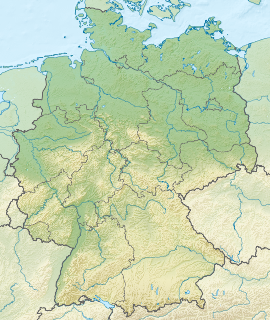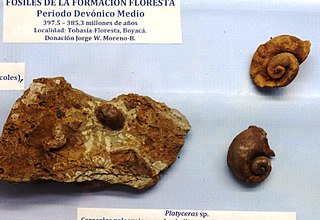 W
WThe Ahbach Formation is a geologic formation in Germany. It preserves fossils dating back to the Middle Devonian period.
 W
WThe Beartooth Butte Formation is a geologic formation in Wyoming. It preserves fossils dating back to the Devonian period.
 W
WThe Catavi Formation is a Pridoli to Emsian geologic formation of northern and central Bolivia. The formation comprises a 456 m (1,496 ft) thick succession of fine-grained, olive to brown sandstones and siltstones, shales and black limestones deposited in a shallow to deep marine environment.
 W
WThe Devonian Catskill Formation or the Catskill Clastic wedge is a unit of mostly terrestrial sedimentary rock found in Pennsylvania and New York. Minor marine layers exist in this thick rock unit. It is equivalent to the Hampshire Formation of Maryland, West Virginia, and Virginia.
 W
WThe Contadero Formation is a geologic formation in the San Andres Mountains of New Mexico. It preserves fossils dating back to the late Devonian period.
 W
WThe Cuche Formation is a geological formation of the Floresta Massif, Altiplano Cundiboyacense in the Eastern Ranges of the Colombian Andes. The sequence of siltstones, shales, and sandstone beds dates to the Late Devonian and Early Carboniferous periods, and has a maximum thickness of 900 metres (3,000 ft).
 W
WThe Floresta Formation is a geological formation of the Altiplano Cundiboyacense in the Eastern Ranges of the Colombian Andes. The sequence of siltstones, shales, coquinas and sandstone beds dates to the Devonian period; Late Emsian, Eifelian and Early Givetian epochs, and has a maximum thickness of 600 metres (2,000 ft). The unit is highly fossiliferous; brachiopods, bryozoans, gastropods, trilobites, corals and bivalves have been found in the Floresta Formation. Some fragments of Placoderm fish fossils were found in the Floresta Formation, while the overlying Cuche Formation is much richer in fish biodiversity.
 W
WThe Devonian Foreknobs Formation is a mapped bedrock unit in Pennsylvania, Maryland, Virginia, and West Virginia.
 W
WThe Gamoneda Formation is an Emsian geologic formation of southern Bolivia. The approximately 340 metres (1,120 ft) thick formation comprises marine micaceous grey siltstones and burrowed grey sandstones and shales.
 W
WThe Devonian Hamilton Group is a mapped bedrock unit in the United States. The unit is present in New York, Pennsylvania, Maryland, Ohio and West Virginia. In Virginia, it is known as the laterally equivalent Millboro Shale. The group is named for the village of Hamilton, New York. Details of stratigraphic nomenclature for this unit as used by the U.S. Geological Survey are available on-line from the National Geologic Map Database. These rocks are the oldest strata of the Devonian gas shale sequence.
 W
WThe Klerf Formation is an Early Devonian (Emsian) formation that includes a Lagerstätte in the Northern Eifel hills, at Willwerath near Prüm, Rhineland-Palatinate, Germany. In it Jaekelopterus rhenaniae, a giant eurypterid was discovered. The Klerf Formation, comprising greenish and reddish shales, siltstones and sandstones, was first described in 1919 by Rudolf Richter (1881-1957) and reaches a maximum thickness of about 1,300 metres (4,300 ft).
 W
WThe Lock Haven Formation is a Devonian mapped bedrock unit in Pennsylvania, in the Appalachian Mountains of the United States.
 W
WThe Lucas Formation is a geologic formation in Michigan. It preserves fossils dating back to the Devonian period.
 W
WThe Marcellus Formation or the Marcellus Shale is a Middle Devonian age unit of sedimentary rock found in eastern North America. Named for a distinctive outcrop near the village of Marcellus, New York, in the United States, it extends throughout much of the Appalachian Basin.
 W
WThe Milwaukee Formation is a fossil-bearing geological formation of Middle Devonian age in Milwaukee County, Wisconsin. It stands out for the exceptional diversity of its fossil biota. Included are many kinds of marine protists, invertebrates, and fishes, as well as early trees and giant fungi.
 W
WThe Onate Formation is a geologic formation that is exposed in most of the highlands of south-central New Mexico. It preserves fossils dating back to the middle Devonian period.
 W
WThe Onondaga Limestone is a group of hard limestones and dolomites of Devonian age that form an important geographic feature in some areas in which it outcrops; in others, especially its Southern Ontario portion, the formation can be less prominent as a local surface feature.
 W
WThe Mississippian Pocono Formation is a mapped bedrock unit in Pennsylvania, Maryland, and West Virginia, in the United States. It is also known as the Pocono Group in Maryland and West Virginia, and the upper part of the Pocono Formation is sometimes called the Burgoon Formation or Burgoon Sandstone in Pennsylvania. The Pocono is a major ridge-former In the Ridge-and-Valley Appalachians of the eastern United States
 W
WThe Silica Formation is a geologic formation in Michigan. It preserves fossils dating back to the Devonian period.
 W
WThe Sly Gap Formation is a geologic formation in south-central New Mexico. It preserves fossils dating back to the Frasnian Age of the late Devonian period.